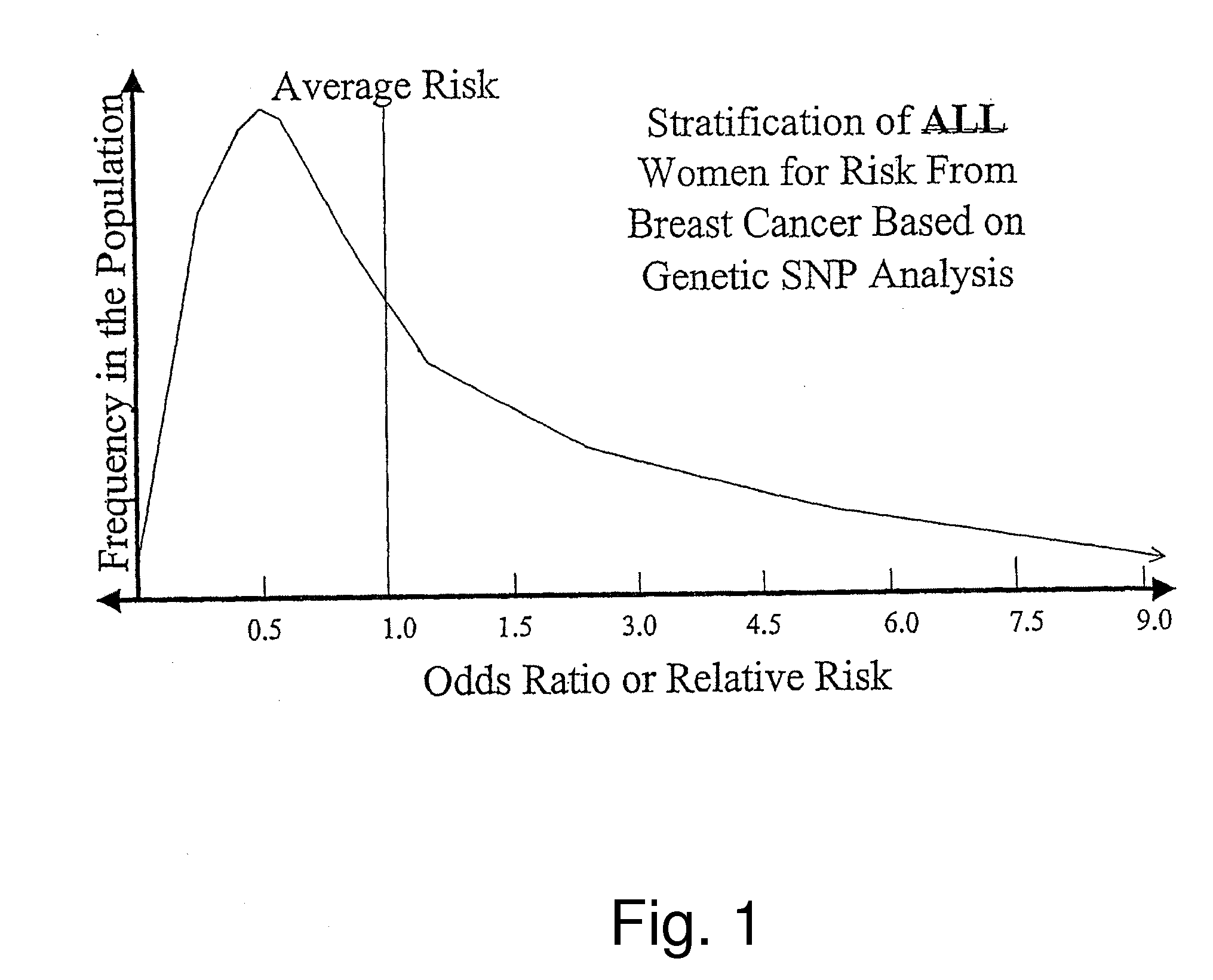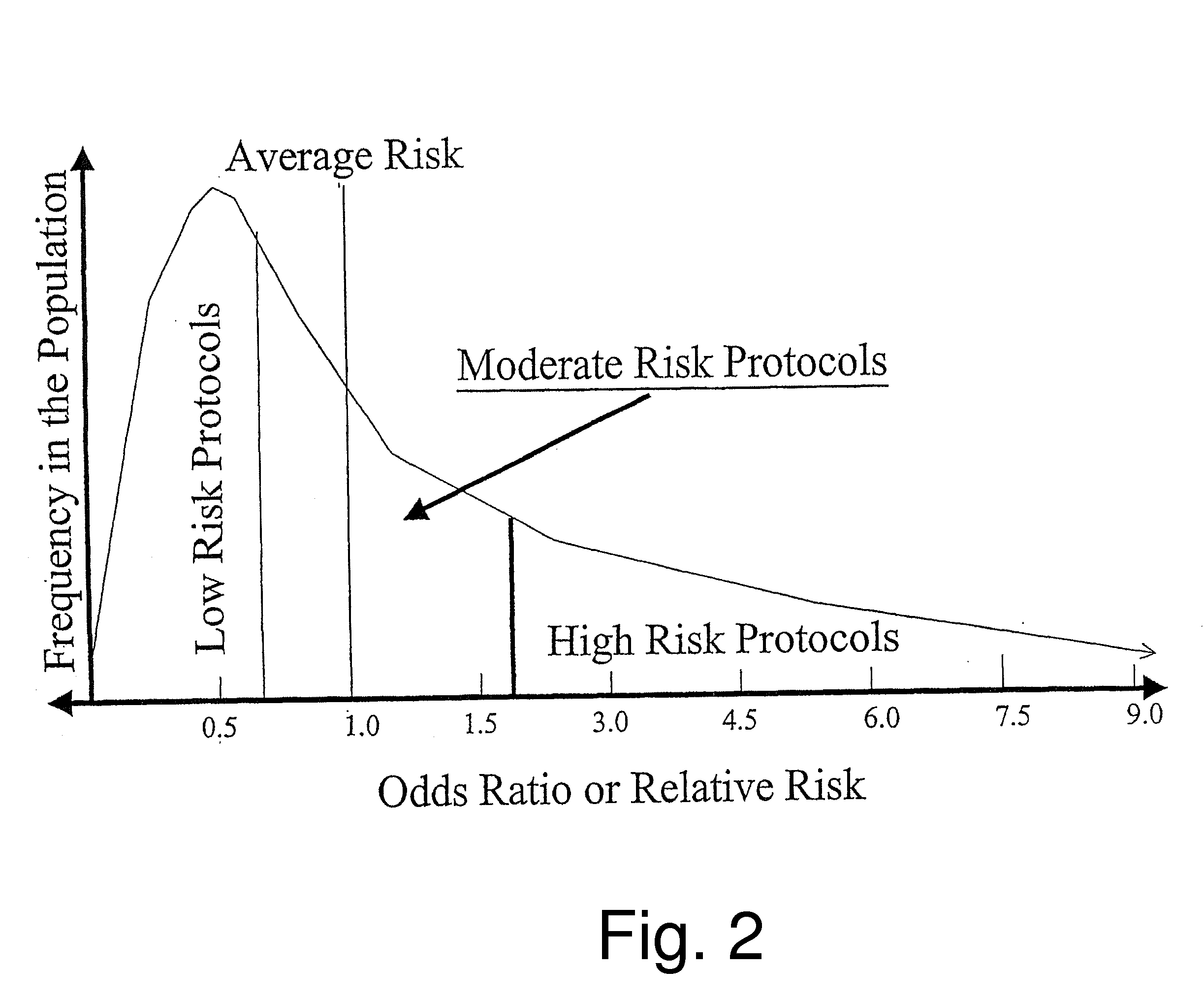Genetic Analysis For Stratification of Cancer Risk
a genetic analysis and risk stratification technology, applied in the field of genetic analysis for stratification of cancer risk, can solve the problems of relatively high cost of cancer screening tests, poor prognosis of patients regardless of treatment, and inability to accurately detect cancer risk
- Summary
- Abstract
- Description
- Claims
- Application Information
AI Technical Summary
Benefits of technology
Problems solved by technology
Method used
Image
Examples
example 1
Methods
[0120]DNA specimens from individuals who had been diagnosed with breast cancer or from cancer free controls were arrayed on 96-well PCR plates. Operators were blinded as to information about whether individual specimens were from cancer patients or controls. Also, included among specimens arrayed on the 96-well plates were DNA specimens of known genotypes and no template control blank wells. PCR was performed with gene specific primer pairs that flanked the sites of the genetic polymorphisms that were assayed. The gene specific PCR products were typically digested with restriction endonucleases that recognize and cleave one allele of the SNPs but not the other. Restriction digested PCR products were then displayed by electrophoresis and scored as restriction fragment length polymorphisms (RFLPs). For those genetic polymorphisms that were caused by insertions or deletions of DNA sequences in one allele of a polymorphism relative to the other allele, the polymorphisms were assa...
example 2
Results: Not Age Stratified
[0123]The inventors examined the association of various genetic polymorphisms with breast cancer. The data set used in this analysis consisted of nearly 600 women that have been diagnosed with breast cancer and approximately 1400 women who had never been diagnosed with any cancer. Twenty different genetic polymorphisms were examined. The DNA specimens were assigned numbers for reference but were otherwise stripped of personal identifiers. The results presented in Tables 2A-C are a synthesis of a complex bootstrap analysis performed many different ways. In general, when examined singly (one at a time), the polymorphism were weakly associated with risk of a breast cancer diagnosis. As a group, they may be termed common risk alleles with low penetrance or no penetrance for the breast cancer phenotype. The surprising observation made during this study was that when examined in combination (in pairs or in combinations of three or more), complex genotypes were d...
example 3
Results: Age Stratified Below 54
[0125]In addition to the analyses discussed above, further analyses were performed to stratify the breast cancer cases by age of diagnosis. Stratifying by age is the first example of using a personal history measure with genetic analysis to more accurately estimate an individual's cancer risk. Stratifying by age made an important difference in which combinations of genes were important for estimating risk from breast cancer.
[0126]The results presented in Tables 3A-C are a synthesis of a complex bootstrap analysis performed many different ways. The data set used in this analysis consisted of nearly 340 women that have been diagnosed with breast cancer and approximately 900 women who had never been diagnosed with any cancer. All women in this analysis were under the age of 54 when they were diagnosed with breast cancer or, if cancer free, at the time that their DNA was collected for this study. Twenty different genetic polymorphisms were examined. In ge...
PUM
| Property | Measurement | Unit |
|---|---|---|
| pH | aaaaa | aaaaa |
| temperature | aaaaa | aaaaa |
| temperature | aaaaa | aaaaa |
Abstract
Description
Claims
Application Information
 Login to View More
Login to View More - R&D
- Intellectual Property
- Life Sciences
- Materials
- Tech Scout
- Unparalleled Data Quality
- Higher Quality Content
- 60% Fewer Hallucinations
Browse by: Latest US Patents, China's latest patents, Technical Efficacy Thesaurus, Application Domain, Technology Topic, Popular Technical Reports.
© 2025 PatSnap. All rights reserved.Legal|Privacy policy|Modern Slavery Act Transparency Statement|Sitemap|About US| Contact US: help@patsnap.com



